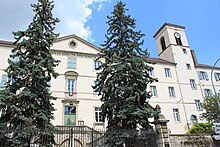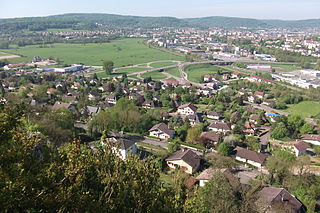Vesoul | |
|---|---|
Prefecture and commune | |
| Coordinates: 47°37′23″N6°09′21″E / 47.6231°N 06.1558°E | |
| Country | France |
| Region | Bourgogne-Franche-Comté |
| Department | Haute-Saône |
| Arrondissement | Vesoul |
| Canton | Vesoul-1 and 2 |
| Intercommunality | CA Vesoul |
| Government | |
| • Mayor (2020–2026) | Alain Chrétien [1] |
Area 1 | 9.07 km2 (3.50 sq mi) |
| Population (2022) [2] | 15,306 |
| • Density | 1,700/km2 (4,400/sq mi) |
| Demonym | Vésulien(ne) |
| Time zone | UTC+01:00 (CET) |
| • Summer (DST) | UTC+02:00 (CEST) |
| INSEE/Postal code | 70550 /70000 |
| Elevation | 213–375 m (699–1,230 ft) (avg. 220 m or 720 ft) |
| 1 French Land Register data, which excludes lakes, ponds, glaciers > 1 km2 (0.386 sq mi or 247 acres) and river estuaries. | |
Vesoul (French pronunciation: [vəzul] ⓘ və-ZOOL) is a commune in the predominantly rural Haute-Saône department, of which it is the prefecture, or capital, in the region of Bourgogne-Franche-Comté located in eastern France.
Contents
- History
- Geography
- Governance and politics
- Mayors
- Twin towns
- Administrative division
- Population and society
- Demography
- Media
- Sport
- Education
- Culture and heritage
- Monuments and tourist attractions
- Festival
- Library
- Areas
- Notable people
- Awards
- Climate
- See also
- References
- External links
It is the most populated municipality of the department, with 15,212 inhabitants in 2014. The same year, the Communauté d'agglomération de Vesoul, which covers 20 municipalities, together had 34,310 inhabitants, while its urban area, comprising 78 municipalities, had 59,244 inhabitants. Its inhabitants are known in French as Vésuliens.
Built on top of the hill of La Motte in the first millennium under the name of Castrum Vesulium,[ citation needed ] the city gradually evolved into a European commercial and economic center. At the end of the Middle Ages, the city experienced a challenging period beset with plagues, epidemics, and localized conflict.
The main urban center of the department, Vesoul is also home to a major PSA parts manufacturing plant and to the Vesoul International Film Festival of Asian Cinema. It was immortalized by Jacques Brel in his 1968 song "Vesoul".






































